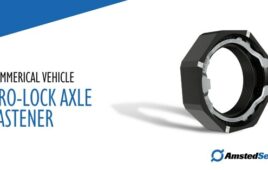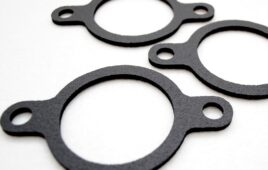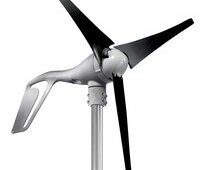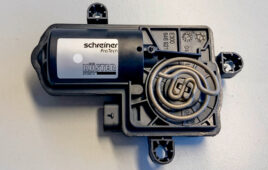
The process to match a sealing system to more-stringent cylinder demands is straightforward. First, review the impact of the operating environment. Then factor in component layout, mating hardware, and operating conditions to establish an effective sealing system.
The first article in this series, in our July 2008 issue, explained what you should considerwhen hydraulic cylinders must move faster or operate under stronger conditions. Here’s the rest of the story.
Lasting longer
Cylinders are being pushed for increased life. Sealing systems, crucial for cylinder function, are highly stressed components with a defined useful lifetime. To increase their life and ensure effectiveness over extended periods of time, it can be important to address the primary effects of fatigue, aging, wear and contamination .
Fatigue is caused by repeated cycling of high stress over a long period of time. In sealing systems, fatigue is most evident by fractures and missing material in the sealing system components. Its effects are limited life and changing friction and leakage performance of the sealing system. For cylinders, a fatigued sealing system can cause:
Position control issues. Friction changes in the sealing system affect the feedback loop, causing the potential for over and under-shoot.
Load limitations. Seals cannot handle the pressure and this limits load capacity.
Increased energy consumption. Extra energy is needed to move the load due to the higher friction caused by changing seal performance.
Shorter Life. Sealing system life is a factor that equates to cylinder life. As seals fatigue and eventually fail, it affects cylinder life.
Increased Cost. Costs increase due to increased energy consumption, downtime due to decreased sealing system life, and possible hardware damage due to debris.
As fatigue is caused by repeated cycling of stress over an extended period of time, cylinder manufacturers need to reduce the amplitude or frequency of the cycling.
Sealing system suppliers dealing with fatigue issues investigate ways to limit the amount of stress on sealing system components using the following approaches:
Change the design. Lower the internal stresses in the sealing components. One way is to use a spring energized seal with a special spring, which has very low internal stresses, shown below.
Add components, such as backup rings to limit deformation will limit stresses.
Change materials to those with higher load capacities.
Lower the friction to reduce internal stresses on components. This can be done by reducing seal-contact stress, changing the design to allow for a different footprint, adjusting fluid film under the seal, or changing the material.

Spring-energized seal design and special spring.
In addition to individual efforts by the cylinder manufacturer and sealing supplier, joint efforts can help:
Ensure proper surface finish, rod hardness and surface coating. Proper finish and hardness allow an adequate fluid film under the seal and help limit internal seal stresses.
Understand fluid conditions. Changes in viscosity and potential fluid breakdown affect the fluid film thickness which the seals ride on; too thin may result in high internal stresses in the seals.
Understand potential hardware dynamics and effectively communicating it. There needs to be joint understanding of the operating conditions in which the seal can experience cyclic high stresses, such as: pressure buildup, ballooning, dithering or hard start/stop.
Understand assembly. As some of the changes from the sealing system supplier concern design, address added material or changes in material and assembly.
Aging and its effects must be accounted for. Temperature and media also are significant factors in how seal designs react to aging. These effects can degrade how a sealing system performs and over time will alter its useful life. Cylinder manufacturers see aging affecting:
Position control. Seal performance changing as reflected in friction. As friction changes, it affects the feedback loop causing the potential for over and under-shoot.
Energy consumption. Increased energy is needed due to the subsequent higher frictions.
Life. Sealing system life and cylinder life are linked.
As aging affects sealing systems useful life, it also affects the cylinder’s useful life.
Cylinder manufacturers work to counter these effects through:
Understanding fluid behavior through its life cycle. Changes in viscosity and fluid breakdown affect the fluid film that the seal rides.
Understanding the operating conditions near the sealing system. This information will better define the environment that the sealing system will live in and help determine the appropriate design, layout and materials.
Lowering high end operating temperatures. Higher heat generally has an adverse effect on sealing system performance. This was addressed in the ‘Moving Faster-Higher Heat’ section and is applicable here.
For sealing system suppliers, there are two approaches to investigate:
Reduce the overall friction of the system, thus lowering the operating temperature. You can do this by changing seal contact, by design changes or material changes, and adjusting the fluid film under the seal.
Understand the effects of creep, stress relaxation and compatibility over time and design with these factors in mind. It’s essential to ensure compatibility with the fluid, especially as the fluid breaks down over time and changes due to possible contaminates. Sealing system suppliers need to look into using increased creep-resistant materials and materials with higher retained loading over time.

Chart of retained sealing force over time.
Additional efforts can be done jointly. As mentioned in Part I of this series, joint efforts to reduce heat are relevant to combat aging. They are:
• Ensure proper rod hardness and surface coating
• Maximize the load distribution on the bearing
• Change lubrication pattern underneath the bearings
• Understand spacing and location of the bearing relative to the seals
• Understand sealing system component layout and the effect on fluid film thickness to reduce friction and thus heat
• Understand fluid conditions
• Understand potential hardware dynamics
Wear is yet another enemy that keeps cylinders from lasting longer. Here are additional wear-related issues to consider:
For the sealing system supplier, consider changes in material characteristics over time due to creep, stress relaxation or fluid compatibility and its effect on wear.
For the cylinder manufacturer, minimize potential additional movement in the system due to wear of components outside of the sealing system, such as connecting pins.
Fluid breakdown also affects wear.
Contamination is caused by internal wear, which generates contaminates, and also by external sources. As cylinders are asked to last longer, contamination has a greater effect on the sealing system by affecting life, friction and leakage. Cylinder manufacturers see similar effects, with changes in:
• Position control
• Energy consumption
• Life
• Cost
For contamination, cylinder manufacturers improve fluid filtering and reduce possible collection points and opportunities for contamination to enter the system.
Sealing system suppliers take multiple approaches to combat contamination:
Trap contaminates by using ingestion ring
Use more wear-resistant materials which can handle the contamination more effectively
Try to eliminate ingress of contaminates by scraping, wiping, or sealing contaminates more effectively. An example of this is the seal below with a polyurethane scraper that has a dual scraping feature. This particular design also reduces pressure build up through a pressure-relieving feature contained within the seal. The feature allows the seal to operate in a near atmospheric condition, regardless of the operating condition, thus avoiding the potential for scraper extrusion or poor wiping performance.

Dual-acting scraper seal.

Contamination failure of polyurethane seal.
It’s important to understand operating conditions and where debris can arise. The application failure shown here occurred when water entered the system. Combined with operating temperature, the water destroyed the seal.
Stronger
Cylinders are moving toward stronger or harsher working conditions:
Increased operating pressure
Higher energy density – same operating pressures but with reduced packaging size either diametrically or axially
These desirable operating conditions, though, can trigger undesirable effects like material deformation, hardware dynamics, loss of fluid film integrity, wear and higher heat.
Material deformation occurs when the compliant materials used in sealing system components have greater deflection with increasing operating pressure, resulting in movement to free space. There are two types of movement:
Extrusion. Material moves to a point where it protrudes into the gap of the hardware. The seal shown below failed because of extrusion.
Lay-down. Material conforms to the running surface, thus changing its footprint.

Extrusion failure of seal.
Regardless of how the seal material deforms, it effects the sealing system and the cylinder. For the sealing system, the effect of material deformation is a loss of leakage control, frictional change, and limited life. This, in turn, may affect:
Positional control. As the friction changes in the sealing system, it affects the feedback loop in the cylinder and thus positional control.
Load capability. Increased leakage in the sealing system will not allow the cylinder to move the desired load.
Energy consumption.
Cost.
Life. Sealing system life and cylinder life are linked. Deformation will cause loss of sealing system performance and will eventually limit the cylinder’s useful life.
Although material deformation of the sealing system components may seem to be the sole responsibility of the sealing system supplier, there are efforts that can be done by cylinder manufacturer alone, sealing system suppler alone, and jointly to contend with material deformation.
For the cylinder manufacturer, those actions are:
Reduce the extrusion gap to allow more support for sealing system components
Ensure alignment, so that the extrusion gap is minimized and the seal is not in localized high-stress conditions
Design the system to reduce constant pressure conditions, such as putting in a mechanical stop to eliminate a situation of constant high pressure loading
Reduce Heat.
For the sealing system supplier, there are two primary avenues to pursue:
Change to a more robust sealing system component design by:
Change the design of components to ensure that the design will not deform to a point that severely impacts performance. The diagram below shows how deformation is affected by pressure levels.
Add components, such as backup rings, to limit deformation, which will limit stresses
Change materials to those with higher capacity loading
Lower the friction. As heat has a great impact on sealing system component deformation, lowering the friction will reduce the temperature around the seal. Steps to take are:
• Reduce seal contact stress
• Change the design to allow for a different footprint
• Adjust fluid film under the seal
• Change the material




How a design change can limit impact of increased pressure.
There are three areas where a joint effort by the sealing system supplier and the cylinder manufacturer can assist in limiting sealing system component material deformation from higher operating pressures:
Reduce heat.
Ensure proper surface finish, rod hardness and surface coating. Proper finish for the sealing system allows adequate fluid film, which will reduce friction, heat, and material deformation.
Change lubrication pattern underneath the bearings.
Understand sealing system component layout and the effect on fluid film thickness to reduce friction and heat
Jointly understand the potential of fluid breakdown and its effects on the fluid film thickness
Alignment.
Maximize the load distribution on the bearing.
Understand spacing and location of the bearing relative to the seals. Unsuitable location will not allow adequate support for alignment and will result in higher loading of the sealing components and thus higher heat.
Effectively communicate the duty cycle and the assembly process.
Fluid film failure can cause adverse effects like dieseling, cause of the failure shown below.
Sealing components. Seals are energized by the fluid. In stronger operating conditions this causes the seal to have greater stress on the fluid film.
Air ingression into the system.
Operating conditions, including rapid acceleration or deceleration of the fluid

This seal damage was caused by dieseling.
The fluid film is of great importance for sealing systems as it directly relates to leakage control, friction, and life of the sealing system. Without an adequate fluid film, the sealing system will not be able to perform, causing the cylinder to have problems like:
Position control. As the friction changes in the sealing system, this affects the feedback loop in the cylinder and thus positional control.
Energy consumption.
Life. Life of the sealing system and cylinder are linked. Loss of fluid film due to breakdown or change in viscosity can eventually lead to limited life. Dieseling and explosive decompression are more catastrophic instances which also limit life of the sealing system and thus the cylinder.
Overall cost.
Cylinder manufacturers ensure fluid film integrity by:
Ensuring the plumbing and valving have minimal effect on fluid viscosity changes or breakdown
Minimizing rapid acceleration or deceleration of the fluid near the sealing system to limit the possibility of explosive decompression.
Ensuring against air ingression through tank design, filling method, orientation or flow patterns to reduce the potential for dieseling.
Ensuring fluid stability so that the viscosity changes are limited and that its composition limits the chance for dieseling
Ensuring alignment to minimize high localized loading of the sealing system components.
Minimizing tolerance conditions to limit the amount of variation the seal has to accommodate in the hardware, which will narrow down the internal stress in the sealing system components.
Material selection is a way to combat dieseling and explosive decompression. Dieseling requires higher strength materials that will withstand the combustion of the air. However, higher strength materials are less compliant. Friction, leakage control and assembly are additional issues associated with higher strength materials. Explosive decompression is also dealt with in materials, but in a different fashion. You can limit the materials’ ability to absorb gases, maximize the material to release gases, or improve the strength to resist damage.
For viscosity changes and fluid breakdown, sealing system suppliers investigate both bearings and seals.
For bearings, the main target is to ensure that the design, material, and its location relative to the seals will be able to handle the pressure, provide the necessary support, and aid in forming a fluid film for the seals, all while staying within the system cost targets.
For seals, the main emphasis is to investigate the use of materials and designs that will handle the increased pressure.
A secondary effort would be to lower the friction, causing a decrease in the temperature near the seal. Ways of doing this are to reduce seal contact stress, change the design to allow for a different footprint, adjust fluid film under the seal or change the material.
Cylinder manufacturer and sealing system supplier may take additional actions to ensure fluid film integrity due to cylinders running stronger. They are similar to areas previously mentioned in Part I.
Hardware dynamics become a greater concern as hardware is pushed to operate in stronger conditions:
Hardware ballooning/internal hardware deformation. Deformation of the hardware due to pressure
Side loading. Moving more load over the total stroke imparts side loading.
Fatigue. Cycling modes of high stress over an extended period of time has a potential impact on both sealing components and various cylinder components.
Vibration/noise. With higher pressures, vibration of the cylinder may not allow for the seal to track the mating components effectively.
Pressure buildup. Pressure buildup is due to the valving/plumbing allowing for pressure spikes.
Contamination. With higher pressures, contamination has greater momentum and may destroy the sealing components.
The listed hardware dynamics are a result of various factors such as pressure, system plumbing (valving and accumulators), filters, component connections and operating conditions to name a few. In general, these dynamic issues affect the sealing system leakage, friction and life, which affect the cylinders’ position control, loading capabilities, energy consumption, life and overall cost.
Trelleborg Sealing Systems
www.trelleborg.com
::Design World::





Tell Us What You Think!